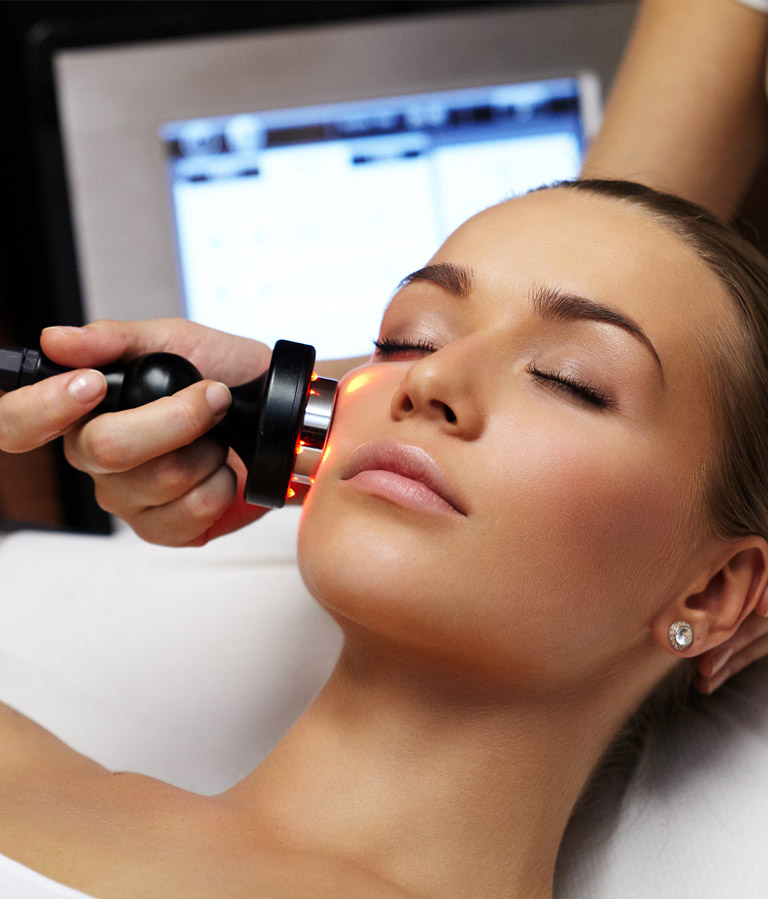The procedure described, also known as RF therapy, is a treatment that uses radio frequency energy to heat skin tissue. The process is applied in various fields of medicine and cosmetology, with the purpose of improving skin condition and stimulating collagen production. The technology is based on the use of high-frequency electric current that generates radio waves. Depending on the device used, this frequency can range from a few hundred kHz to several MHz.
How does radio frequency treatment work?
The main way radio frequency therapy works is through selective heating of tissues. Radio waves penetrate the skin, where the energy is transformed into heat. This phenomenon leads to the heating of collagen fibres in the dermis, causing them to contract and thicken. This process results in the stimulation of fibroblasts, the cells responsible for producing collagen, elastin and hyaluronic acid.
Types of radio frequencies used in treatments
Radio waves can be divided into several types based on their frequency and method of application:
1. Monopolar radio waves. Their characteristic feature is that they have one pole on the device’s head, while the other pole is on the surface of the patient’s body. These waves penetrate tissues at a greater depth, allowing for action on deeper layers of the skin.
2. Bipolar radio waves. In this case, the two poles are located on the treatment head, which limits the penetration of the waves to more superficial layers of the skin. For this reason, bipolar waves are often used in treatments targeting shallower skin layers.
3. Multipolar radio waves. This is a more advanced version of bipolar waves that features more than two poles. This allows for even more controlled distribution of energy in the skin.
4. High-frequency radio waves. These waves have a higher frequency, which allows for a slightly more superficial and gentle impact on the skin. They are often used in treatments on sensitive areas of the body, such as around the eyes.
What does a procedure with radio waves entail?
Radio frequency treatment begins with cleansing the skin, after which a conductive gel is applied. The gel is designed to facilitate the penetration of radio waves into the skin and ensure the proper glide of the treatment head. During the procedure, the device’s head emits radio waves that penetrate the tissues and heat them to the appropriate temperature. The treatment usually takes between 20 and 60 minutes, depending on the treated body area.
During the procedure, the patient may feel warmth, which is the result of the radio waves. In most cases, it is not painful, but may be sensed as a slight burning or tingling sensation. During the procedure, the specialist supervises the intensity of the radio waves to adjust it to the patient’s individual needs.
What should you know before the procedure?
It is important to consult an experienced specialist before undergoing radio frequency treatment. Any contraindications that may affect the procedure should be discussed. Contraindications may include various health conditions, such as heart disease, ongoing skin infections, pregnancy or metal implants in the treatment area.
It is also recommended to inform the specialist about any medications, dietary supplements and previous aesthetic treatments. Before the procedure, the patient should avoid tanning and the use of skin irritants such as chemical peels. The skin should be well moisturised. It is not recommended, however, to apply intensive cosmetic treatments immediately before the procedure.
Everything you need to know about radio frequency treatments
Radio frequency treatment is a procedure based on the use of radio wave energy to heat skin tissues, stimulating collagen production. There are various types of radio waves, which differ in their method of application and depth of action. This procedure is relatively simple, but requires proper preparation and consultation with a specialist to ensure it is performed properly. This technology is one of the tools used in aesthetic medicine.


